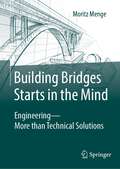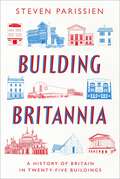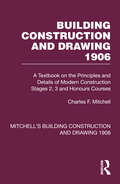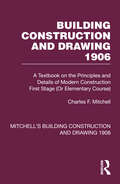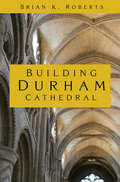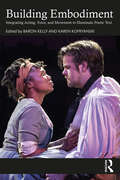- Table View
- List View
Building Anglo-Saxon England
by John BlairA radical rethinking of the Anglo-Saxon world that draws on the latest archaeological discoveriesThis beautifully illustrated book draws on the latest archaeological discoveries to present a radical reappraisal of the Anglo-Saxon built environment and its inhabitants. John Blair, one of the world's leading experts on this transformative era in England's early history, explains the origins of towns, manor houses, and castles in a completely new way, and sheds new light on the important functions of buildings and settlements in shaping people's lives during the age of the Venerable Bede and King Alfred.Building Anglo-Saxon England demonstrates how hundreds of recent excavations enable us to grasp for the first time how regionally diverse the built environment of the Anglo-Saxons truly was. Blair identifies a zone of eastern England with access to the North Sea whose economy, prosperity, and timber buildings had more in common with the Low Countries and Scandinavia than the rest of England. The origins of villages and their field systems emerge with a new clarity, as does the royal administrative organization of the kingdom of Mercia, which dominated central England for two centuries.Featuring a wealth of color illustrations throughout, Building Anglo-Saxon England explores how the natural landscape was modified to accommodate human activity, and how many settlements--secular and religious—were laid out with geometrical precision by specialist surveyors. The book also shows how the Anglo-Saxon love of elegant and intricate decoration is reflected in the construction of the living environment, which in some ways was more sophisticated than it would become after the Norman Conquest.
Building Anglo-Saxon England
by John BlairA radical rethinking of the Anglo-Saxon world that draws on the latest archaeological discoveriesThis beautifully illustrated book draws on the latest archaeological discoveries to present a radical reappraisal of the Anglo-Saxon built environment and its inhabitants. John Blair, one of the world's leading experts on this transformative era in England's early history, explains the origins of towns, manor houses, and castles in a completely new way, and sheds new light on the important functions of buildings and settlements in shaping people's lives during the age of the Venerable Bede and King Alfred.Building Anglo-Saxon England demonstrates how hundreds of recent excavations enable us to grasp for the first time how regionally diverse the built environment of the Anglo-Saxons truly was. Blair identifies a zone of eastern England with access to the North Sea whose economy, prosperity, and timber buildings had more in common with the Low Countries and Scandinavia than the rest of England. The origins of villages and their field systems emerge with a new clarity, as does the royal administrative organization of the kingdom of Mercia, which dominated central England for two centuries.Featuring a wealth of color illustrations throughout, Building Anglo-Saxon England explores how the natural landscape was modified to accommodate human activity, and how many settlements--secular and religious—were laid out with geometrical precision by specialist surveyors. The book also shows how the Anglo-Saxon love of elegant and intricate decoration is reflected in the construction of the living environment, which in some ways was more sophisticated than it would become after the Norman Conquest.
Building Anglo-Saxon England
by John BlairA radical rethinking of the Anglo-Saxon world that draws on the latest archaeological discoveriesThis beautifully illustrated book draws on the latest archaeological discoveries to present a radical reappraisal of the Anglo-Saxon built environment and its inhabitants. John Blair, one of the world's leading experts on this transformative era in England's early history, explains the origins of towns, manor houses, and castles in a completely new way, and sheds new light on the important functions of buildings and settlements in shaping people's lives during the age of the Venerable Bede and King Alfred.Building Anglo-Saxon England demonstrates how hundreds of recent excavations enable us to grasp for the first time how regionally diverse the built environment of the Anglo-Saxons truly was. Blair identifies a zone of eastern England with access to the North Sea whose economy, prosperity, and timber buildings had more in common with the Low Countries and Scandinavia than the rest of England. The origins of villages and their field systems emerge with a new clarity, as does the royal administrative organization of the kingdom of Mercia, which dominated central England for two centuries.Featuring a wealth of color illustrations throughout, Building Anglo-Saxon England explores how the natural landscape was modified to accommodate human activity, and how many settlements--secular and religious—were laid out with geometrical precision by specialist surveyors. The book also shows how the Anglo-Saxon love of elegant and intricate decoration is reflected in the construction of the living environment, which in some ways was more sophisticated than it would become after the Norman Conquest.
Building Bridges Starts in the Mind: Engineering - More than Technical Solutions
by Moritz MengeBeing a civil engineer is a fulfilling profession. Civil engineers design sustainable infrastructure. We build houses, roads, bridges, tunnels, cultural centres, towers and much more. We often bring all our engineering skills to bear to achieve solid solutions. And often even more, which lies beyond the technical art of engineering.The book looks beyond the technical solutions into the wider environment of civil engineers and reflects on their profession and their own attitude from a wide variety of perspectives. "Building bridges begins in the mind" means engaging in the search for connections - to a holistic professional image and to one's position as an engineer.
Building Britannia: A History of Britain in Twenty-Five Buildings
by Steven ParissienAn ambitious history of Britain told through the stories of twenty-five notable structures, from the Iron Age fortification of Maiden Castle in Dorset to the Gherkin.Building Britannia is a chronicle of social, political and economic change seen through the prism of the country's built environment, but also a sequence of closely observed studies of a series of intrinsically remarkable structures: some of them beautiful or otherwise imposing; some of them more coldly functional; all of them with richly fascinating stories to tell.Steven Parissien tells both a national story, tracing how a growing sense of British nationhood was expressed through the country's architecture, and also examines how these structures were used by later generations to signpost, mythologise or remake British history.Rubbing shoulders with some 'expected' building choices – the Roman baths at Aquae Sulis, the early Gothic splendour of Lincoln Cathedral and the Tudor jewel that is Little Moreton Hall – are some striking inclusions that promise to open doors into what will be, for many readers, less familiar areas of social history: these include The Briton's Protection, a Regency pub close in Manchester city centre and the Edwardian Baroque Electric Cinema in Notting Hill, one of the country's oldest working cinemas. Thus as well as identifying the relevance of certain iconic structures to the unfolding of the national story, Building Britannia finds fascination and meaning in the everyday and the disregarded.
Building Change: Architecture, Politics and Cultural Agency
by Lisa FindleyBuilding Change investigates the shifting relationships between power, space and architecture in a world where a number of subjected people are reasserting their political and cultural agency. To explore these changes, the book describes and analyzes four recent building projects embedded in complex and diverse historical, political, cultural and spatial circumstances. The projects yield a range of insights for revitalizing the role of architecture as an engaged cultural and spatial practice.
Building Change: Architecture, Politics and Cultural Agency
by Lisa FindleyBuilding Change investigates the shifting relationships between power, space and architecture in a world where a number of subjected people are reasserting their political and cultural agency. To explore these changes, the book describes and analyzes four recent building projects embedded in complex and diverse historical, political, cultural and spatial circumstances. The projects yield a range of insights for revitalizing the role of architecture as an engaged cultural and spatial practice.
Building China: Informal Work and the New Precariat
by Sarah SwiderRoughly 260 million workers in China have participated in a mass migration of peasants moving into the cities, and construction workers account for almost half of them. In Building China, Sarah Swider draws on her research in Beijing, Guangzhou, and Shanghai between 2004 and 2012, including living in an enclave, working on construction jobsites, and interviews with eighty-three migrants, managers, and labor contractors. This ethnography focuses on the lives, work, family, and social relations of construction workers. It adds to our understanding of China’s new working class, the deepening rural-urban divide, and the growing number of undocumented migrants working outside the protection of labor laws and regulation. Swider shows how these migrants—members of the global "precariat," an emergent social force based on vulnerability, insecurity, and uncertainty—are changing China’s class structure and what this means for the prospects for an independent labor movement.The workers who build and serve Chinese cities, along with those who produce goods for the world to consume, are mostly migrant workers. They, or their parents, grew up in the countryside; they are farmers who left the fields and migrated to the cities to find work. Informal workers—who represent a large segment of the emerging workforce—do not fit the traditional model of industrial wage workers. Although they have not been incorporated into the new legal framework that helps define and legitimize China’s decentralized legal authoritarian regime, they have emerged as a central component of China’s economic success and an important source of labor resistance.
Building Co-operation: A Business History Of The Co-operative Group, 1863-2013
by John F. Wilson Anthony Webster Rachael Vorberg-RughBuilding Co-operation traces the development of The Co-operative Group and its predecessor, the Co-operative Wholesale Society (CWS), over the course of 150 years. Born from the efforts of the Rochdale Pioneers and others who established successful consumer co-operatives across Britain in the mid-nineteenth century, by the 1860s the proponents of the CWS were ready to pioneer a new effort: a federation, democratically run and collectively owned, that would enable co-operatives to become their own suppliers. From humble origins, the CWS grew into one of Britain's largest businesses within a generation, pioneering modern retailing and distribution on a national scale, expanding into factory production and financial services, and establishing an international supply network that stretched across Europe, and beyond. Throughout the late nineteenth century and well into the twentieth, co-operative societies provided essential services to millions of members across Britain, ranging from food and clothing to banking, insurance, travel agency, pharmacy and even funeral services. However, in the second half of the twentieth century co-operatives experienced a protracted period of decline, facing a series of internal structural challenges, fierce competition amongst food retailers, and a rapidly-changing marketplace. By the turn of the twenty-first century, when many commentators were ready to consign co-operatives to the past, The Co-operative Group emerged with a revitalised business model that has helped to re-invigorate the British co-operative sector and bring new attention to the important role of co-operative and mutual enterprises worldwide. Based on extensive archival research, including many records available to historians for the first time, Building Co-operation is the story of a distinctive business model as it evolved over time. While since the inauguration of the CWS in 1863 the commercial landscape has changed nearly beyond recognition, the values at the heart of The Co-operative Group have remained relevant to succeeding generations, focusing on member benefits and a commitment to ethical trading.
Building Colonial Cities of God: Mendicant Orders and Urban Culture in New Spain
by Karen MelvinThis book tracks New Spain's mendicant orders past their so-called golden age of missions into the ensuing centuries and demonstrates that they had equally crucial roles in what Melvin terms the "spiritual consolidation" of cities. Beginning in the late sixteenth century, cities became home to the majority of friars and to the orders' wealthiest houses, and mendicants became deeply embedded in urban social and cultural life. Friars ministered to urban residents of all races and social standings and engaged in traditional mendicant activities, serving as preachers, confessors, spiritual directors, alms collectors, educators, scholars, and sponsors of charitable works. Each order brought to this work a distinct identity that informed people's beliefs and shaped variations in the practice of Catholicism. Contrary to prevailing views, mendicant orders flourished during the seventeenth and early eighteenth centuries, and even the eighteenth-century reforms that ended this era were not as devastating as has been assumed.Even in the face of new institutional challenges, the demand for their services continued through the end of the colonial period, demonstrating the continued vitality of baroque piety.
Building Colonialism: Archaeology and Urban Space in East Africa (Debates in Archaeology)
by Daniel T. RhodesBuilding Colonialism draws together the relationship between archaeology and history in East Africa using techniques of artefact, building, spatial and historical analyses to highlight the existence of, and accordingly the need to conserve, the urban centres of Africa's more recent past. The study does this by exploring the physical remains of European activity and the way that the construction of harbour towns directly reflects the colonial mission of European powers in the nineteenth century in Tanzania and Kenya. Based on fieldwork which recorded and analysed the buildings and monuments within these towns it compares the European creations to earlier Swahili urban design and explores the way European commercial trade systems came to dominate East Africa. Based on the kind of Urban Landscape Analyses carried out in the UK and Ireland, Building Colonialism looks at the social and spatial implications of the towns on the Indian Ocean coast which contain centres of derelict and unused buildings dating from East Africa's nineteenth-century colonial era. The book begins by concentrating upon towns in Tanzania and Kenya which were the key entry points into Africa for the nineteenth-century colonial regimes and compares these to later French and Italian colonies and discusses contemporary approaches to the conservation of colonial built heritage and the difficulties faced in ensuring valid participatory protection of the urban heritage resource.
Building Colonialism: Archaeology and Urban Space in East Africa (Debates in Archaeology)
by Daniel T. RhodesBuilding Colonialism draws together the relationship between archaeology and history in East Africa using techniques of artefact, building, spatial and historical analyses to highlight the existence of, and accordingly the need to conserve, the urban centres of Africa's more recent past. The study does this by exploring the physical remains of European activity and the way that the construction of harbour towns directly reflects the colonial mission of European powers in the nineteenth century in Tanzania and Kenya. Based on fieldwork which recorded and analysed the buildings and monuments within these towns it compares the European creations to earlier Swahili urban design and explores the way European commercial trade systems came to dominate East Africa. Based on the kind of Urban Landscape Analyses carried out in the UK and Ireland, Building Colonialism looks at the social and spatial implications of the towns on the Indian Ocean coast which contain centres of derelict and unused buildings dating from East Africa's nineteenth-century colonial era. The book begins by concentrating upon towns in Tanzania and Kenya which were the key entry points into Africa for the nineteenth-century colonial regimes and compares these to later French and Italian colonies and discusses contemporary approaches to the conservation of colonial built heritage and the difficulties faced in ensuring valid participatory protection of the urban heritage resource.
Building Complex Temporal Explanations of Crime: History, Institutions and Agency (Critical Criminological Perspectives)
by Stephen FarrallThis book seeks to bring understanding of both complexity and temporality into criminology. It outlines why these are important in criminological models of causation and explanation and explores them by drawing on theories and approaches in political science, comparative history, social theory and systems analyses. It discusses what is meant by complexity and introduces historical institutionalism (which is rarely used in criminology) to criminological audiences; it introduces what is known as ‘why-because’ analyses to the social sciences. This style of thinking is used to explore the causes of major transportation accidents (such as aeroplane or ferry disasters) and involves the integration of structural, organisational and agentic inputs in accounting for such disasters. Chapters on realistic evaluation, theories of structuration and agency, and research design and research methods are included with an example project based on the author's recent studies of Thatcherism which shows how these theories can be applied to empirical data. This book speaks to those interested in criminology, sociology, political science, research methods and the wider social sciences.
Building Construction and Drawing 1906: A Textbook on the Principles and Details of Modern Construction Stages 2, 3 and Honours Courses (Mitchell's Building Construction and Drawing)
by Charles F. MitchellOriginally published in 1881, but here reissuing the 1906 edition with a new introduction by Stephen J. Scaysbrook, the Mitchell’s Building and Construction Stage 2, 3 and Honours book offers an unparalleled insight into historic construction techniques and materials. Originally written to provide a concise handbook and guide for students and for practitioners, this reissue of Mitchell’s 1906 Advanced and Honours edition now provides a valuable addition to building pathology, allowing students and practitioners to research construction methods and materials pertinent to the period.
Building Construction and Drawing 1906: A Textbook on the Principles and Details of Modern Construction First Stage (Or Elementary Course) (Mitchell's Building Construction and Drawing)
by Charles F. MitchellOriginally published in 1881, but here reissuing the 1906 edition with a new introduction by Stephen J. Scaysbrook, the Mitchell Building and Construction books offer an unparalleled insight into construction techniques and materials. Originally written to provide a concise handbook and guide for students and for practitioners, this reissue of Mitchell’s 1906 First Stage or Elementary Course edition now provides a valuable addition to building pathology, allowing students and practitioners to research construction methods and materials pertinent to the period. Including over 1000 drawings, it is of no surprise to see Mitchell’s First Stage or Elementary edition start with a detailed explanation of the instruments and methods of drawing with pencil ink and tracing paper, emphasising the need to learn basic drawing skills and the need to think about a detail and the materials used to create a detail capable of lasting well over 100 years or more. The simple act of making a scale from a drawing with only one dimension may be lost to modern-day students, but not to Charles Mitchell, who describes the method and its use.
Building Construction and Drawing 1906: A Textbook on the Principles and Details of Modern Construction Stages 2, 3 and Honours Courses (Mitchell's Building Construction and Drawing)
by Charles F. MitchellOriginally published in 1881, but here reissuing the 1906 edition with a new introduction by Stephen J. Scaysbrook, the Mitchell’s Building and Construction Stage 2, 3 and Honours book offers an unparalleled insight into historic construction techniques and materials. Originally written to provide a concise handbook and guide for students and for practitioners, this reissue of Mitchell’s 1906 Advanced and Honours edition now provides a valuable addition to building pathology, allowing students and practitioners to research construction methods and materials pertinent to the period.
Building Construction and Drawing 1906: A Textbook on the Principles and Details of Modern Construction First Stage (Or Elementary Course) (Mitchell's Building Construction and Drawing)
by Charles F. MitchellOriginally published in 1881, but here reissuing the 1906 edition with a new introduction by Stephen J. Scaysbrook, the Mitchell Building and Construction books offer an unparalleled insight into construction techniques and materials. Originally written to provide a concise handbook and guide for students and for practitioners, this reissue of Mitchell’s 1906 First Stage or Elementary Course edition now provides a valuable addition to building pathology, allowing students and practitioners to research construction methods and materials pertinent to the period. Including over 1000 drawings, it is of no surprise to see Mitchell’s First Stage or Elementary edition start with a detailed explanation of the instruments and methods of drawing with pencil ink and tracing paper, emphasising the need to learn basic drawing skills and the need to think about a detail and the materials used to create a detail capable of lasting well over 100 years or more. The simple act of making a scale from a drawing with only one dimension may be lost to modern-day students, but not to Charles Mitchell, who describes the method and its use.
Building Cosmopolitan Communities: A Critical and Multidimensional Approach
by A. NascimentoBuilding Cosmopolitan Communities contributes to current cosmopolitanism debates by evaluating the justification and application of norms and human rights in different communitarian settings in order to achieve cosmopolitan ideals. Relying on a critical tradition that spans from Kant to contemporary discourse philosophy, Nascimento proposes the concept of a "multidimensional discourse community." The multidimensional model is applied and tested in various dialogues, resulting in a new cosmopolitan ideal based on a contemporary discursive paradigm. As the first scholarly text to provide an interdisciplinary survey of the theories and discourses on human rights and cosmopolitanism, Building Cosmopolitan Communities is a valuable resource to scholars of philosophy, political science, social theory, and globalization studies.
Building Democracy in Brazil: The Politics of Constitutional Change, 1985-95 (St Antony's Series)
by Javier Martínez-LaraBuilding Democracy in Brazil is an empirical analysis of the constitution-making process that Brazil underwent in the 1980s as it moved from an authoritarian military regime to a democratic civilian government. The study explores the institutional and political context from which the process departed as well as the choices of the key social and political actors. It then examines in depth the different stages of the constitutional elaboration.
Building Democracy in Late Archaic Athens
by Jessica PagaIn 508/7 B.C.E., after years of chaos and uncertainty, the city of Athens was rocked by a momentous occurrence: the passage of a series of reforms that resulted in what has come to be known as the world's first democracy. Exactly how the Athenians did this is still a fundamental question 2,500 years later. The results of the reforms transformed the very nature of what it meant to be Athenian and their far-reaching effects would come to leave their mark on nearly every aspect of society, including the structures at which they prayed and in which they debated legislation. By attending to the built environment broadly, and monumental architecture specifically, this book investigates the built environment of ancient Athens precisely during this time, the late Archaic period (ca. 514/13 - 480/79 B.C.E.). It was these decades, filled with transition and disorder, when the Athenians transformed their political system from a tyranny to a democracy. Concurrent with the socio-political changes, they altered the physical landscape and undertook the monumental articulation of the city and countryside. Interpreting the nature of the fledgling democracy from a material standpoint, this book approaches the questions and problems of the early political system through the lens of buildings. The focus on monumental structures erected during this particular time period demonstrates how the built environment worked to facilitate the functioning of the nascent political regime. While Athenian democracy--its institutions, ideology, and capabilities--has been intensively studied, little attention has been paid to the intersection between built structures and the political system during its earliest phases. This book draws attention to a pivotal period of Athenian political history through the built environment, thereby exposing the richness of the material record and illustrating how it participated in the creation of a new democratic Athenian identity.
Building Democracy in Late Archaic Athens
by Jessica PagaIn 508/7 B.C.E., after years of chaos and uncertainty, the city of Athens was rocked by a momentous occurrence: the passage of a series of reforms that resulted in what has come to be known as the world's first democracy. Exactly how the Athenians did this is still a fundamental question 2,500 years later. The results of the reforms transformed the very nature of what it meant to be Athenian and their far-reaching effects would come to leave their mark on nearly every aspect of society, including the structures at which they prayed and in which they debated legislation. By attending to the built environment broadly, and monumental architecture specifically, this book investigates the built environment of ancient Athens precisely during this time, the late Archaic period (ca. 514/13 - 480/79 B.C.E.). It was these decades, filled with transition and disorder, when the Athenians transformed their political system from a tyranny to a democracy. Concurrent with the socio-political changes, they altered the physical landscape and undertook the monumental articulation of the city and countryside. Interpreting the nature of the fledgling democracy from a material standpoint, this book approaches the questions and problems of the early political system through the lens of buildings. The focus on monumental structures erected during this particular time period demonstrates how the built environment worked to facilitate the functioning of the nascent political regime. While Athenian democracy--its institutions, ideology, and capabilities--has been intensively studied, little attention has been paid to the intersection between built structures and the political system during its earliest phases. This book draws attention to a pivotal period of Athenian political history through the built environment, thereby exposing the richness of the material record and illustrating how it participated in the creation of a new democratic Athenian identity.
Building Durham Cathedral
by Brian K. RobertsDurham Cathedral was completed nearly 900 years ago, after 40 years of construction. Inevitably it has suffered from the effects of time: physical erosion, from the weather and increasing pollution on stone that was never of the best quality, and cultural erosion, the impact of secular and religious changes – not least the depredations of clerics, improvers, and administrators. Nevertheless, it remains: the stones speak and provide the story of themselves. Building Durham Cathedral explores this magnificent structure by questioning its architectural plans and stonework. As there have been minimal additions we catch sight of it as the Norman builders intended. Remarkably, a few early documents and the stonework itself allow us to glimpse its beginnings and some of the personalities involved. Questions remain, but there may even be a clue to the identity of its original master mason.
Building Early Modern Edinburgh: A Social History of Craftwork and Incorporation
by Aaron AllenMuch like in the present day, building a house in the sixteenth century involved masons, carpenters and glaziers, among others, and in many cities such trades had separate companies to govern their own affairs. In Edinburgh, however, they banded together in a single body – the Edinburgh Incorporation of Mary’s Chapel. Building Early Modern Edinburgh traces the history of the organisation, which sought to control the capital’s building trades and defend their privileges. By utilising a range of previously missing charters and archival documents, the author offers a new perspective on the prestigious and important craft guild in its 543 years of existence. Developing a crucial theme of ‘composite corporatism’, and using the concepts of ‘family’ and ‘household’ to approach an urban institution, this book is a valuable resource of comparative material for the study of craft guilds and urban history in a global context.
Building Early Modern Edinburgh: A Social History of Craftwork and Incorporation
by Aaron AllenA comprehensive history of the provincial administrative and judiciary structure in Ottoman-governed Bulgaria
Building Embodiment: Integrating Acting, Voice, and Movement to Illuminate Poetic Text
by Baron Kelly Karen KopryanskiBuilding Embodiment: Integrating Acting, Voice, and Movement to Illuminate Poetic Text offers a collection of strategic and practical approaches to understanding, analyzing, and embodying a range of heightened text styles, including Greek tragedy, Shakespeare, and Restoration/comedy of manners. These essays offer insights from celebrated teachers across the disciplines of acting, voice, and movement and are designed to help actors and instructors find deeper vocal and physical connections to poetic text. Although each dramatic genre offers a unique set of challenges, Building Embodiment highlights instances where techniques can be integrated, revealing how the synthesis of body, brain, and word results in a fuller sense of character experiencing for both the actor and the audience. This book bridges the gap between academic and professional application and invites the student and professional actor into a richer experience of character and story.

